
The Prophet's Mosque is the second mosque built by the Islamic prophet Muhammad in Medina, after that of Quba, as well as the second largest mosque and holiest site in Islam, after the Masjid al-Haram in Mecca, in the Saudi region of the Hejaz. The mosque is located at the heart of Medina, and is a major site of pilgrimage that falls under the purview of the Custodian of the Two Holy Mosques.

Seiyun is a city in the region and Governorate of Hadhramaut in Yemen. It is located in the middle of the Hadhramaut Valley, about 360 km (220 mi) from Mukalla, the capital of Mukalla District and the largest city in the area, via western route. It is 12 km (7.5 mi) from Shibam and 35 km (22 mi) from Tarim, the other large cities in the valley.

The majority of the Arabs in Singapore are Hadharem and traced their ancestry to the southern Arabian Peninsula in Hadramaut, Yemen. The valley region was part of a confederacy once ruled by the Queen of Sheba. Hadramaut was mentioned in The Old Testament. Its fertile areas, suitable for cultivation, had beguiled ancient Romans to call it, and all South Arabia in general, Arabia Felix.

Istiqlal Mosque in Jakarta, Indonesia is the largest mosque in Southeast Asia and the ninth largest mosque in the world in terms of worshipper capacity. Built to commemorate Indonesian independence, this national mosque of Indonesia was named "Istiqlal", an Arabic word for "independence". The mosque was opened to the public on 22 February 1978. Within Jakarta, the mosque is positioned next to Merdeka Square, the Jakarta Cathedral (Catholic), and also of the Immanuel Church (Reformed).

The Great Mosque of Samarra is a mosque from the 9th century CE located in Samarra, Iraq. The mosque was commissioned in 848 and completed in 851 by the Abbasid caliph Al-Mutawakkil who reigned from 847 until 861. At the time of construction, it was the world's largest mosque. It is known for its 52 metres (171 ft) high minaret encircled by a spiral ramp. The mosque is located within the 15,058-hectare (37,210-acre) Samarra Archaeological City UNESCO World Heritage Site, listed in 2007.

The National Mosque of Malaysia is a mosque in Kuala Lumpur, Malaysia. It has a capacity for 15,000 people and is situated among 13 acres (53,000 m2) of gardens. Its key features are a 73-metre-high (240 ft) minaret and a 16-pointed star concrete main roof. The umbrella, synonymous with the tropics, is featured conspicuously – the main roof is reminiscent of an open umbrella, the minaret's cap a folded one. The folded plates of the concrete main roof are a creative solution to achieving the larger spans required in the main gathering hall. Reflecting pools and fountains are spread throughout the compound. Completed in 1965, the mosque is a bold and modern approach in reinforced concrete, symbolic of the aspirations of a then newly independent nation.

'Abdallah ibn 'Alawi al-Haddad was a Yemeni Islamic scholar. He lived his entire life in the town of Tarim in Yemen's Valley of Hadhramawt and died there in 1720 CE. He was an adherent to the Ash'ari Sunni Creed of Faith (Aqidah), while in Islamic jurisprudence (Fiqh), he was a Sunni Muslim of Shafi'i school.

The Mīqāt Dhu al-Ḥulayfah, also known as Masjid ash-Shajarah or Masjid Dhu al-Hulayfah, is a miqat and mosque in Abyār ʿAlī, Medina, west of Wadi al-'Aqiq, where the final Islamic prophet, Muhammad, entered the state of ihram before performing 'Umrah, after the Treaty of Hudaybiyyah. The mosque is located 7 km (4.3 mi) SW of the Al-Masjid an-Nabawi and was defined by Muhammad as the miqat for those willing to perform the Hajj or Umrah pilgrimages from Medina. It is the second-largest miqat mosque after the Miqat Qarn al-Manazil in As-Sayl al-Kabir.
Ahmad al-Muhajir also known as al-Imām Aḥmad ibn ʿĪsā was an Imam Mujtahid and the progenitor of Ba 'Alawi sada group which is instrumental in spreading Islam to India, Southeast Asia and Africa. He was the son of 'Isa the son Muhammad the son of Ali al-Uraydi who was the fourth son of Imam Ja'far al-Sadiq, a fifth generation descendant of Ali and Fatima, the daughter of Muhammad. He was a known acquaintance of Bishr al-Ḥāfī.
Al-Segaf'/As-Segaf'/Assegaf'/Assegaff'/Al-Saqqāf were Arab Singaporean spice traders of Hadhrami origin, who became influential by marrying into a royal family from the Celebes. They acquired many properties, like the other Arab families, including the "Perseverance Estate" where they grew lemon grass. The estate is now considered to be the heart of the Muslim community in Singapore, with the Alsagoff family still retaining its prominence there. They originally belong to the Ba'Alawi clan of the Bani Hashim in Hadhramaut. Hence, they are a Ba'Alawi Sayyid family. Then-master-chef of the family, Mr. Abdul-Rahman established a restaurant named "Islamic" in 1921 in Singapore, which is functioning till date. As well as being successful merchants and land owners, the family became involved in civic affairs. The family members, at times, held civic office from the 1870s, until Singaporean independence in 1965.

Habib Umar bin Hafiz is a Yemeni Sunni and Sufi Islamic scholar, teacher, and founder and dean of Dar al-Mustafa Islamic seminary. He also a member of the Supreme Advisory Council for the Tabah Foundation in Abu Dhabi.
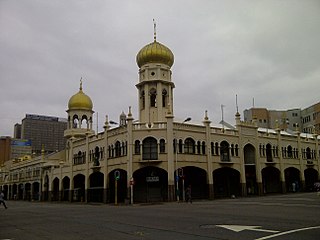
The Juma Mosque of Durban is a mosque located in Durban, Kwazulu-Natal in South Africa. Also known as the Grey Street Mosque, it represents a spiritual center for Durban's Muslims.

The Mosque of the Jinn is a mosque in Mecca, Saudi Arabia, located near Jannat al-Mu'alla. It is also known as the Mosque of Allegiance and the Mosque of Guards because the city's guards would patrol up to that point.

Al-Ijabah Mosque, also known as "Bani Muawiyah Mosque" or "Al-Mubahalah Mosque", is a mosque in Medina, Saudi Arabia, which was built during the time of the Islamic prophet Muhammad on a land owned by Muawiyah bin Malik bin 'Auf of the tribe of As-Sus.
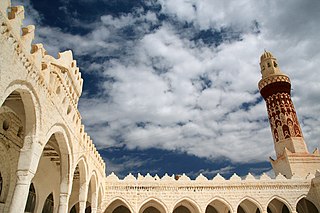
The Mosque of Queen Arwa bint Ahmad Al-Sulayhi, or simply the Queen Arwa Mosque, is a historical mosque in Jibla, Yemen. It was built between 1056 and 1111 C.E. by Queen Arwa al-Sulayhi and her tomb had later become the site of pilgrimage. It retains its importance as one of the oldest ancient Yemeni mosques. It is also known as Hurrat-ul-Malikah Mosque, as the queen was often referred as Al-Malika Al-Hurra, which means "The Noble Queen".

Al-Janad Mosque is an ancient mosque located 20 km southwest of Taiz, Yemen. It is considered the oldest surviving and the first mosque in Yemen built during the beginning of Islam, established by Muadh ibn Jabal who was sent by the Islamic prophet Muhammad to Yemen to teach its people and the provisions regarding the religion and spend among them in accordance with Sharia in the year 6 AH. As such it is one of the most important religious sites in Taiz governorate. It is also known as Mu'adh Mosque.
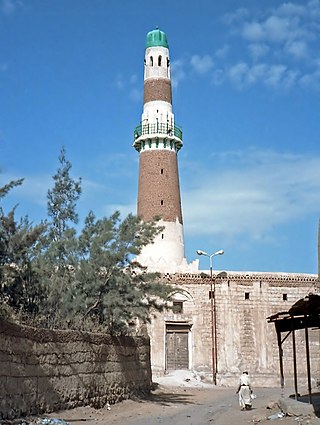
Al-Hadi Mosque or Al-Imam Al-Hadi Mosque is one of the historical mosques of the ancient city of Sa'ada, Yemen. It is located east–west of the city, was built in around 897 C.E., and is named after Imam Yahya Bin Al-Hussein, the founder of the state of Imams of Yemen. The mosque became the oldest place for the teaching of Zaidi maddhab in the Arabian Peninsula.
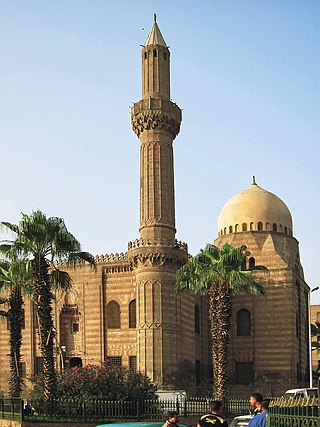
Al-Mahmoudia Mosque or the Mosque of Mahmud Pasha is a historic mosque in the city of Cairo, Egypt. It is located at the Salah al-Din Square in the Citadel of Cairo area, in front of Bab al-Azab gate of the citadel. There are Sultan Hassan Mosque and Al-Rifa'i Mosque to the east.

Tarim is a historic town situated in Wadi Hadhramaut, Yemen. It is widely acknowledged as the theological, juridical, and academic center of the Hadhramaut Valley. An important center of Islamic learning, it is estimated to contain the highest concentration of descendants of the Islamic Prophet Muhammad known as the Sadah anywhere in the world. The city is distinguished for producing numerous Islamic scholars, including Imam al-Haddad. Additionally, Tarim is also home to Dar al-Mustafa, a well-known educational institution for the study of traditional Islamic Sciences.
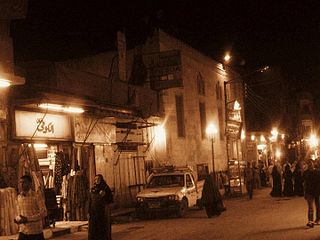
The Sadat Quraish Mosque is a historical mosque located in the city of Bilbeis, Egypt. Some historians believe it was the first mosque in Egypt and that it was founded by Amr ibn al-As in 640 CE.























